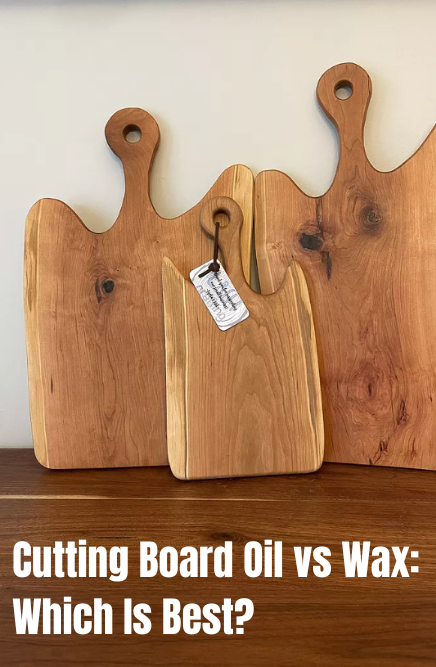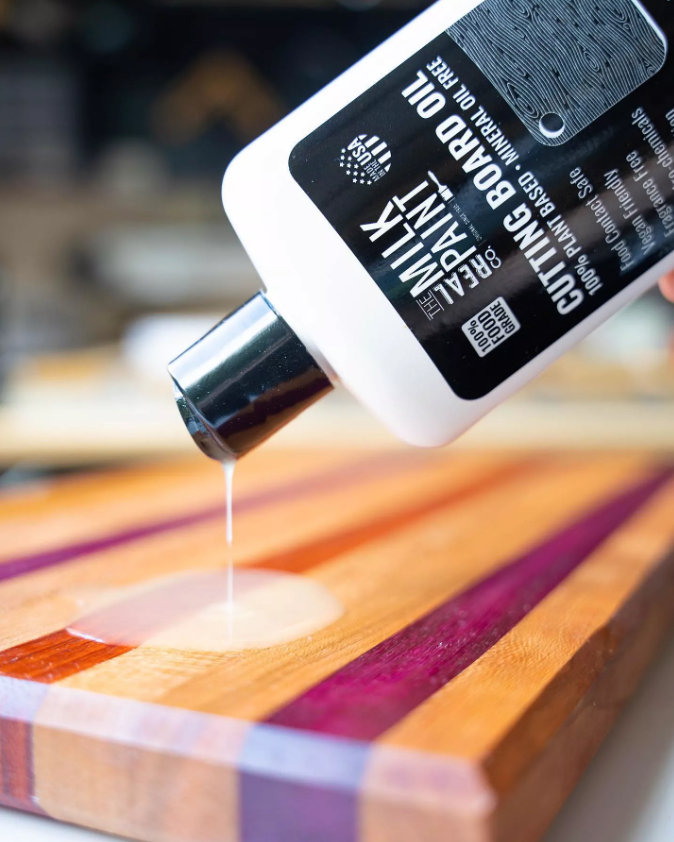Understanding the Right Cutting Board Finish
 Well-made wooden cutting boards last for years, even decades — but only with proper maintenance. Choosing the right finish also makes a difference, and RMP Finishes comes to the rescue with handcrafted, food-safe care for wooden cutting boards, butcher block surfaces and handmade utensils and tools.
Well-made wooden cutting boards last for years, even decades — but only with proper maintenance. Choosing the right finish also makes a difference, and RMP Finishes comes to the rescue with handcrafted, food-safe care for wooden cutting boards, butcher block surfaces and handmade utensils and tools.
Designed to prevent drying, cracking and moisture absorption, RMP Finishes prevent warping and bacteria buildup. This protective barrier is why your decision comes down to cutting board oil vs. wax finishes. Both products protect your wood, but they work differently. Understanding the difference between cutting board oil and wax helps you choose the best cutting board finish for your needs.
What Does Cutting Board Oil Do?
The best oil for cutting board treatment penetrates deeply, nourishing wood from the inside out. Oils replace the natural moisture wood loses over time, preventing cracking, splitting and drying when you know how to oil a cutting board correctly. Made from non-drying oils that give your wood a warm, rich appearance, RMP’s Cutting Board Oil (crafted from almond oil, palm fruit oil, grapefruit seed oil, rice wax, and hemp floral wax) never hardens or cures.
The benefit? You can apply it and use your board right away for quick upkeep.
So, is cutting board oil food-safe? The answer is yes. Our food-safe formulation means you can prep food immediately on the surface after enhancing the wood grain. For best results, apply Cutting Board Oil regularly. Daily-use boards may need a light weekly coat, while less frequently used boards may go months between applications. Our handy guide for how to oil a cutting board ensures proper maintenance since it wears away faster than wax.
Maximize wood protection by using RMP’s Cutting Board Oil to protect kitchen essentials.
What Does Cutting Board Wax Do?
When using cutting board wax vs. oil, remember it works differently. Instead of soaking deeply into the wood, it seals against moisture and blocks bacteria with its protective surface barrier. For the best wax for cutting board protection, RMP’s Wood Wax combines carnauba wax and walnut oil, a drying oil that cures over 1 to 2 days into a hard protective layer.
This cured finish lasts longer than oil alone, so you don’t need frequent reapplication. Wood Wax also adds a silky-smooth texture and subtle sheen, making it ideal for use as a topcoat over Cutting Board Oil. And yes, our all-natural, food-safe formula meets CPSC safety standards for food-contact surfaces, ensuring confident kitchen use.
RMP’s Wood Wax helps you protect your own wooden items.
Cutting Board Oil vs Wax: Key Differences
Compare your options confidently with this quick guide that breaks down the essentials of oil vs. wax for cutting board protection.
| Feature | Cutting Board Oil | Cutting Board Wax |
|---|---|---|
| Penetration | Deep nourishment into wood | Surface-level protection |
| Curing Time | Nondrying (ready to use immediately) | Requires curing time (forms a hard layer) |
| Frequency of Use | Needs more frequent reapplication | Lasts longer between applications |
| Finish Look | Matte, natural appearance | Glossy or satin finish |
| Best For | Everyday maintenance, quick care | Long-term protection, polishing |
| RMP Products | Cutting Board Oil | Wood Wax |
When to Use Both Oil and Wax (The Ideal Combo)
 You don’t have to choose between cutting board oil or wax — many DIYers maximize protection with both. RMP Finishes work well together, and using both offers wood complete care. For how to apply cutting board oil and wax, use this quick layering method:
You don’t have to choose between cutting board oil or wax — many DIYers maximize protection with both. RMP Finishes work well together, and using both offers wood complete care. For how to apply cutting board oil and wax, use this quick layering method:
- Oil your board first to deeply nourish and restore the wood.
- Wax afterwards to seal in moisture for a durable barrier.
What to use on a cutting board that’s new, dry or heavily used? Follow these steps:
- Clean and dry your board with mild soap.
- Apply and let the oil soak into the wood.
- Add wax and allow 1 to 2 days for curing.
- Buff the surface for a smooth finish.
Enjoy total wood care by teaming up Cutting Board Oil and Wood Wax from RMP Finishes.
How to Apply Cutting Board Oil and Wax for Long-Lasting Results
Knowing how to apply cutting board oil and wax helps protect your wood. Gather supplies and keep these instructions handy for top-notch results. Alternatively, use this guide for refinishing a cutting board if yours needs extra help.
You’ll need:
- A soft lint-free cloth
- Paper towel roll
- Your cutting board
- Space with good ventilation
How to Oil a Cutting Board
- Wipe the board clean and dry it with a paper towel.
- Apply a thin, even oil coat with the cloth.
- Ensure the oil penetrates for 15 to 20 minutes.
- Wipe away the excess oil with a paper towel.
How to Wax a Cutting Board
- Once you let the oil soak in, rub a thin layer of wax onto the surface.
- Let the wax cure for 1 to 2 days for optimal protection.
- Buff the board with a clean cloth for a beautiful finish.
Use the water droplet test to know when it’s time for reapplication — if water no longer beads on the surface, it’s time for maintenance. This handy wood wax sealer guide provides more advice on reapplication. Get inspiration for wood projects by browsing our finishing oils gallery and waxes gallery.
Why Choose RMP Finishes for Your Cutting Board Care Needs?
At RMP Finishes — formerly the Real Milk Paint Co. — we use natural, non-toxic ingredients with zero volatile organic compounds (VOCs) for eco-friendly projects. Our food-safe formulas work great in the kitchen, and our eco-conscious products biodegrade easily for a healthier planet. From bamboo boards to heirloom maple, our finishes protect and showcase wood.
Answers to Common Questions (FAQs)
Is cutting board oil food safe?
Yes. RMP’s Cutting Board Oil is made from food-safe, natural ingredients and contains no harmful VOCs.
How often should I oil my cutting board?
For daily-use boards, reapply oil once a week or when wood appears dry. For light use, once a month may suffice.
Can I use both cutting board oil and wax?
Absolutely! Using both offers the best of deep hydration and surface protection.
Does wax cure faster than oil?
No. RMP’s Wood Wax contains walnut oil and requires 1–2 days to cure, whereas Cutting Board Oil is non-drying and ready for use right away.
What’s the best oil for cutting boards made of bamboo or hardwood?
RMP’s Cutting Board Oil is suitable for most wood types, including bamboo, maple, and walnut.
Find the Best Finish for Your Cutting Board With RMP
Maintain wood with Cutting Board Oil when you cook often, and use Wood Wax for a polished protective finish that lasts. For the best of both worlds, layer the two together. Our handcrafted products with all-natural ingredients provide full-spectrum care for the kitchen and beyond.
Contact us to discuss our safe, effective and easy-to-use finishes and get help creating care routines that preserve and protect your wood.